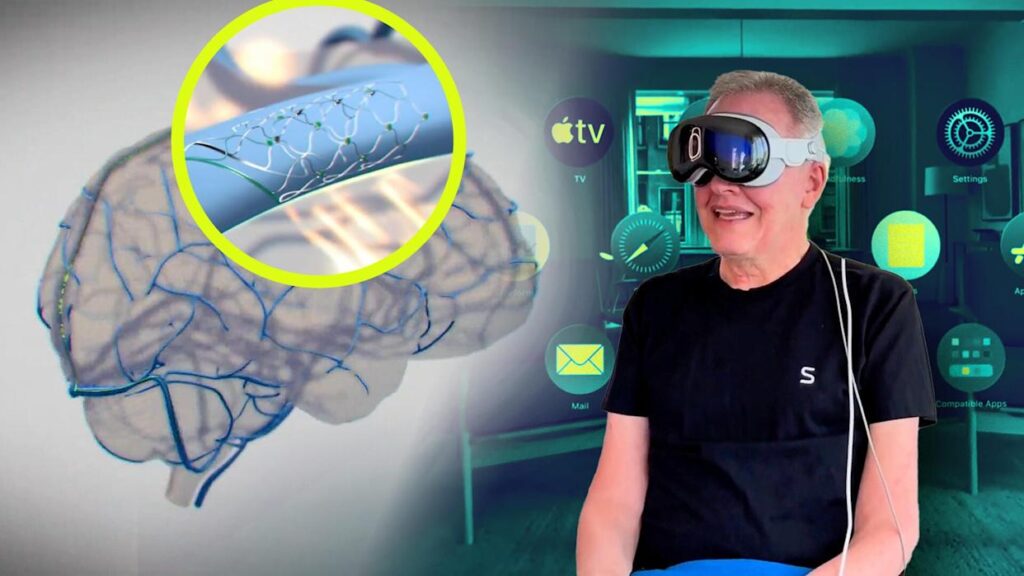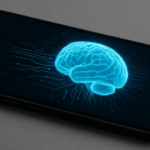Introduction
Technology has always held the promise of making life easier—but for millions of people with disabilities, the digital world often remains just out of reach. From navigating smartphones to interacting with smart devices, many still face barriers due to physical limitations. But that’s beginning to change.
In a groundbreaking move, Apple has partnered with Synchron, a neurotechnology startup developing brain-computer interface (BCI) implants. This futuristic solution allows individuals to control digital devices using only their thoughts—no hand gestures, voice commands, or physical movement needed. Synchron’s minimally invasive implant reaches the brain’s motor cortex through blood vessels, translating neural signals into digital actions.
What makes this even more exciting is Apple’s commitment to accessibility, design, and user privacy. Together, these two companies are pushing the limits of what’s possible, aiming to bring mind-controlled technology into real-world applications by the end of the decade.
This article explores how this collaboration could transform accessibility as we know it—making tech more inclusive, empowering, and human-centric than ever before.
2. The Accessibility Gap: Challenges Faced by People with Disabilities
Despite rapid advancements in technology, millions of people with physical disabilities still face significant barriers when it comes to accessing and interacting with modern digital devices. From smartphones and tablets to laptops and smart home systems, most technology is built with assumptions of fine motor control, hand-eye coordination, or verbal communication, all of which may not be feasible for individuals with mobility impairments, paralysis, or neurodegenerative diseases like ALS or multiple sclerosis.
While assistive tools like voice control, screen readers, eye-tracking software, and adaptive keyboards have helped bridge the gap to some extent, they are far from perfect. Voice assistants can misinterpret commands, eye-tracking systems require precise calibration and stable head movement, and most assistive tools struggle with real-time responsiveness or complex tasks like navigating apps, typing detailed messages, or browsing online content independently.
Another challenge is accessibility across platforms. Many apps and websites are not design with inclusivity in mind, making them difficult to navigate using traditional assistive tools. For those who rely on caregivers or external assistance just to perform basic digital tasks, this leads to a constant dependence on others and a loss of personal autonomy.
Moreover, the emotional toll of exclusion from the digital world is significant. Technology is not just about communication—it’s about education, employment, entertainment, and social connection. For people with disabilities, limited access to these spaces means being left behind in a world that’s increasingly digitized.

That’s where the emerging field of brain-computer interfaces (BCIs) presents a breakthrough opportunity. By using brain signals to control devices, BCIs offer a direct, intuitive, and hands-free method for people with disabilities to interact with technology—no touch, voice, or movement needed.
Apple’s collaboration with Synchron targets this very problem, aiming to transform accessibility into seamless, thought-driven interaction. This isn’t just a technological upgrade—it’s a massive leap toward true inclusion and independence for those who’ve been left on the margins of the digital revolution.
3. What Is Brain-Computer Interface (BCI) Technology?
Brain-Computer Interface (BCI) technology is a groundbreaking innovation that allows a direct communication pathway between the human brain and external devices—like computers, smartphones, or robotic limbs. In simpler terms, BCIs let people control technology using only their brain activity, bypassing the need for physical movement or speech.
At the core of BCI technology are electrical signals produce by neurons in the brain. These signals represent thoughts, intentions, or commands. With the help of sensors or implants, BCIs detect these signals and convert them into digital instructions that machines can understand. For example, thinking about moving your hand could trigger a cursor to move on a screen or initiate an app on a device.
There are two main types of BCIs:
- Non-invasive BCIs, like EEG headsets, read signals from outside the skull but tend to be less precise.
- Invasive BCIs, like Synchron’s implant, are inserted inside or near the brain, offering more accurate and reliable signal detection.
What makes Synchron’s approach special is its minimally invasive technique—inserting a tiny device through blood vessels to reach the brain’s motor cortex, avoiding open-brain surgery. This not only makes the process safer but also more accessible for patients with severe conditions like paralysis or ALS.
BCI technology has already shown promise in helping people regain communication, control prosthetics, and interact with software platforms. Now, with tech giants like Apple entering the field, the potential for mainstream, real-world applications—such as thought-controlled iPhones or iPads—is rapidly becoming a reality.
As BCI tech matures, it could revolutionize not just assistive technology but the way all humans interact with machines, making our connection to the digital world more natural, faster, and incredibly inclusive.
4. Meet Synchron: The Startup Powering Thought-Controlled Tech
Synchron is a U.S.-based neurotechnology startup that has quickly risen to prominence for its pioneering work in brain-computer interface (BCI) systems. Founded in 2016 by Dr. Thomas Oxley, Synchron’s mission is to create technology that restores autonomy to people with paralysis and other severe motor impairments. While many companies are racing toward BCI solutions, Synchron stands out because of its minimally invasive approach and real-world clinical progress.
At the heart of Synchron’s innovation is the Stentrode, a tiny device roughly the size of a paperclip. Unlike traditional BCI implants that require open-brain surgery, the Stentrode is inserted via a catheter through the jugular vein, navigating through blood vessels until it reaches the motor cortex, the part of the brain responsible for movement. This endovascular method makes the procedure far safer and more scalable, removing many of the barriers that have held back BCI adoption.
Once implanted, the device records brain signals and sends them wirelessly to an external receiver worn on the chest. These signals are then translate into digital commands that allow users to control devices with their thoughts—from typing messages and browsing the internet to operating smart home tools.
Synchron’s technology is already being tested in human patients. In 2022, the company received FDA approval for its first U.S.-based clinical trial, making it the first company to gain such approval for an implantable BCI device. One of the trial participants—an ALS patient—was able to use the technology to control his smartphone and communicate online without any physical input.
With backing from investors like Bill Gates and Jeff Bezos, and now Apple, Synchron is quickly becoming a central player in the neurotech space. Their focus on real-world usability, safety, and ethical responsibility positions them as a trusted leader in the movement to bring mind-controlled technology to those who need it most.
5. Apple’s Role: Driving Mainstream Accessibility with AI + Design
Apple has long been recogniz as a leader in accessibility innovation. From VoiceOver and AssistiveTouch to Live Captions and haptic feedback, the company has continually developed tools that help users of all abilities engage with their products. But its recent partnership with brain-computer interface (BCI) pioneer Synchron marks a major leap forward—combining cutting-edge AI, sleek hardware design, and human-centered thinking to redefine what’s possible for people with disabilities.
Rather than merely adapting current tech for accessibility, Apple is investing in a fundamentally new way to interact with devices: using thought alone. This aligns with Apple’s broader mission to create “technology that is inclusive by design.” With Synchron’s Stentrode implant providing the neural interface, Apple’s role is to transform those brain signals into intuitive actions on familiar devices like the iPhone, iPad, and Apple Vision Pro.
The company’s deep expertise in machine learning and natural language processing (NLP) is likely to play a central role. AI will be responsible for interpreting brain signal patterns and converting them into meaningful commands—whether typing text, navigating interfaces, or issuing voice-like prompts to Siri. Apple’s vast on-device AI capabilities also address one of the most important concerns in healthcare: privacy. By processing sensitive brain activity locally rather than in the cloud, users can retain greater control over their personal data.
In typical Apple fashion, the goal is not just to make brain-controlled tech functional, but to make it beautifully seamless. For example, integration with iOS or visionOS could allow users to swipe through apps, write emails, or use FaceTime with simple cognitive commands—without the need for any specialized hardware beyond what they already own.
This partnership also signals Apple’s potential influence in bringing BCIs to mainstream markets, not just clinical ones. With its global ecosystem, massive user base, and commitment to accessibility, Apple could help shift the conversation around disability from limitations to empowerment.
By bringing together medical innovation, intuitive design, and responsible AI, Apple is helping ensure the future of BCI is not just technologically advanced, but also human-first—revolutionizing how people with disabilities live, work, and connect.
6. How It Works: From Thought to Action (Step-by-Step)
The concept of controlling a device with your mind might sound like science fiction, but thanks to Synchron’s brain-computer interface (BCI) and Apple’s innovation, it’s quickly becoming a reality. Here’s a step-by-step breakdown of how this remarkable system works—transforming thoughts into digital actions.
Step 1: Implantation via Blood Vessel
Unlike traditional BCIs that require risky brain surgery, Synchron uses a minimally invasive method. A tiny device called the Stentrode—a flexible mesh containing electrodes—is inserted into the jugular vein and guided into a blood vessel near the motor cortex, the part of the brain responsible for movement.
Step 2: Detecting Brain Signals
Once in place, the Stentrode starts detecting electrical signals generated by the brain. These signals represent the user’s intentions, such as wanting to move a cursor, select a button, or type a letter.
Step 3: Transmitting the Data
The detect signals and sent wirelessly to a small transmitter implanted in the chest. This transmitter securely relays the brain activity data to an external device—like an iPhone or iPad—via Bluetooth or a similar connection protocol.
Step 4: AI-Powered Signal Interpretation
This is where Apple’s AI expertise shines. Advanced machine learning algorithms process the incoming brain signals and translate them into specific, actionable commands. For example, if the user imagines moving their hand to the right, that signal could be interpreted as swiping right on the screen.
Step 5: Real-Time Control of Devices
The translated command is then execute instantly on the Apple device—allowing users to navigate interfaces, open apps, compose messages, or even control VR environments, all without physical movement.
Step 6: Learning and Adapting
Over time, the system can learn from the user’s brain patterns, becoming more accurate and personalized. It adapts to each user’s unique neural activity, improving usability and speed.
This seamless process—from thought to action—has the potential to revolutionize accessibility, giving users with severe physical limitations the ability to interact with technology as naturally as anyone else.
7. Real-World Impact: Use Cases for People with Disabilities
The integration of brain-computer interface (BCI) technology by Synchron and Apple opens up transformative possibilities for people with disabilities. Beyond the technical innovation, it’s the real-world impact that truly defines its importance. From restoring independence to enabling communication, the applications are far-reaching.
Communication for People with ALS
One of the most promising use cases is for individuals with Amyotrophic Lateral Sclerosis (ALS) or similar neurodegenerative diseases. Many of these users lose the ability to speak or move but retain full cognitive ability. With Synchron’s BCI, they can control their iPhone or iPad with their thoughts, typing messages or using speech-to-text software via mental cues alone—restoring their voice in a digital world.
Device Control for Quadriplegic Individuals
For those with spinal cord injuries or paralysis, even basic device interaction becomes difficult. This technology enables them to open apps, browse the web, manage smart home systems, or attend virtual meetings, using thought-based navigation. It shifts control back into their hands—without needing to move them.
Access to Education and Employment
Disabled individuals often face barriers to online learning or remote work due to limitations in traditional device access. With BCI-driven interfaces, they can engage in Zoom calls, write documents, and operate professional software, enabling more equitable participation in digital education and the workforce.
Enhanced Independence in Daily Life
Tasks like setting reminders, ordering groceries, controlling lights, or making calls become manageable independently through the thought-to-action interface. This boosts emotional well-being, self-confidence, and personal freedom for users who previously needed constant assistance.
Immersive Accessibility in Virtual Spaces
As the metaverse and virtual reality evolve, BCIs could allow users with disabilities to navigate VR environments, attend virtual events, or even enjoy gaming experiences. All without physical motion—pushing inclusivity into the next frontier.
These use cases illustrate not just convenience, but life-changing empowerment. Synchron and Apple’s collaboration isn’t just about futuristic tech—it’s about restoring dignity and expanding opportunity for people with disabilities worldwide.
8. Synchron vs Neuralink: Different Paths to Brain-Tech Innovation
While both Synchron and Neuralink are pioneering the brain-computer interface (BCI) space, their approaches, philosophies, and timelines differ significantly. Understanding these distinctions is key to grasping how the future of brain-tech might unfold.
Invasiveness and Surgical Approach
Neuralink, founded by Elon Musk, requires open-skull surgery to implant a chip directly into the brain’s tissue. The process, though promising in terms of data precision, raises high surgical risk and accessibility concerns. In contrast, Synchron’s approach is far less invasive. Its Stentrode implant is inserted via the jugular vein, navigating through blood vessels to reach the motor cortex—no open-brain surgery required. This method, akin to stent placement in cardiology, makes it more scalable and safer for wide adoption.
Clinical Progress and Approval Path
Synchron has a head start in clinical trials and regulatory progress. It received FDA approval for human trials in the U.S. in 2021 and has already implanted its device in patients, with real-world use cases showing early success. Neuralink, despite attention-grabbing demos (like controlling a computer cursor with a monkey’s brain), is still working through human trial approvals and safety validation hurdles.
Focus and Use Cases
Neuralink has broader ambitions—ranging from curing blindness to boosting cognitive function, even claiming potential for “symbiosis with AI.” While visionary, these goals remain theoretical for now. Synchron, on the other hand, is laser-focus on practical accessibility, targeting communication and device control for people with severe paralysis. Their incremental, clinically grounded strategy appeals to medical professionals and regulatory bodies alike.
Company Culture and Public Perception
Neuralink is known for its tech startup energy and bold claims, while Synchron operates more like a medical device company, collaborating with doctors and universities. This contrast shapes public and professional trust—Synchron is seen as cautious and user-centric, while Neuralink is often viewed as disruptive and experimental.
| Feature | Synchron | Neuralink |
| Implant Method | Via blood vessels | Direct brain tissue |
| FDA Trial Approval | Yes | In progress |
| Focus Area | Accessibility, BCI | General cognition, AI |
| Invasiveness | Minimally invasive | Highly invasive |
| Target Market | Medical (disabled users) | Broader enhancement |
Both companies are vital to the neurotech movement—but for now, Synchron’s safer, tested, and accessibility-driven path may bring real-world benefits sooner.
9. Ethical and Social Considerations
As brain-computer interface (BCI) technology moves closer to real-world deployment—particularly through companies like Apple and Synchron—it brings with it a host of ethical and social challenges that must be thoughtfully addressed. While the potential for restoring independence and communication for disabled users is immense, the implications go far beyond the technology itself.
Privacy and Data Security
One of the biggest concerns surrounding BCIs is the sensitive nature of brain data. These systems record signals that represent thoughts, intentions, or movements—raising critical questions about who owns this data, how it is stored, and whether it can be hacked or misused. Companies like Apple, known for their privacy-first approach, will need to implement rigorous data protection protocols to maintain user trust.
Informed Consent and Autonomy
For users—especially those with cognitive or physical impairments—informed consent becomes complex. Users must fully understand what data is being collected, how it is interpreted, and how the implant might affect their thinking or behavior. There is a moral responsibility to ensure that participation in trials or long-term use is voluntary, transparent, and reversible.
Equity and Access
Like many emerging technologies, BCIs risk becoming tools only for the privileged. If implants like Synchron’s are expensive or tied to premium ecosystems (e.g., Apple devices), low-income users or public healthcare systems might be left behind. Ensuring equal access will be critical to avoiding a new form of digital divide.
Identity and Human Enhancement
BCIs challenge our traditional notions of identity, control, and ability. What happens when people can control devices with their thoughts? Could this extend to enhanced memory or faster learning? While exciting, this also prompts fears about “mind hacking,” manipulation, or cognitive overload. Ethically, society must decide how far is too far.
Legal and Policy Frameworks
Governments and regulatory bodies will need to create new frameworks to define acceptable use, liability, and protection for users. This includes setting clear standards for manufacturers and researchers to prevent abuse and ensure accountability.
In summary, while brain-tech promises to transform lives, it must be rolled out with strong ethical guardrails, social awareness, and regulatory clarity—so that innovation doesn’t outpace humanity.
10. What Lies Ahead: Predictions for 2030 and Beyond
As Apple and Synchron continue advancing their brain-computer interface (BCI) collaboration, experts believe the technology could redefine digital accessibility by 2030. What now feels futuristic—controlling devices with thoughts—may soon become a normal part of daily life for millions of people with disabilities.
Mainstream Accessibility by 2030
If ongoing clinical trials succeed and regulatory hurdles are clear, BCIs could become commercially available to a global audience by the end of this decade. We’re likely to see individuals with paralysis using their thoughts to operate iPhones, tablets, smart TVs, and even smart home devices—without any physical interaction. This could significantly improve independence, communication, and quality of life.
Expansion Beyond Accessibility
Although the first use cases focus on helping people with disabilities, experts predict the tech will eventually expand into wider applications—from mental health therapy and cognitive rehabilitation to hands-free work tools in complex environments like healthcare or aviation. Developers may build apps specifically optimized for thought-based navigation.
Regulatory and Ethical Evolution
By 2030, we can also expect global regulations to be in place, protecting users’ brain data, ensuring informed consent, and providing safety standards for both medical and consumer-grade BCIs. Apple’s privacy-first branding could influence how the entire neurotech industry approaches data ethics.
The New Digital Interface
We may be entering a future where keyboards and touchscreens are no longer the only way to interact with technology. Instead, thoughts, intentions, and neural patterns will serve as the interface. For many users, especially those with physical challenges, that shift will be life-changing.
In summary, the next few years could usher in a paradigm shift, where thought-controlled tech moves from labs into homes, schools, and hospitals—making the digital world more inclusive, intuitive, and empowering than ever before.
11. Conclusion: A New Era of Tech Without Limits
The collaboration between Apple and Synchron marks the beginning of a powerful new era—one where technology adapts to human thought, not just touch or voice. By bringing brain-computer interface (BCI) technology into the mainstream, these innovators are redefining what’s possible for people with disabilities and beyond.
This isn’t just about cool tech—it’s about restoring dignity, independence, and control to those who have been limited by physical impairments. From controlling an iPhone with your mind to navigating digital spaces hands-free, the future looks incredibly promising. As we move toward 2030, the vision is clear: a world where limitations are removed, and digital access is universal. With ethical innovation, user-centered design, and responsible development, Apple and Synchron are helping to create a future where technology truly works for everyone—powered by the human mind itself.



